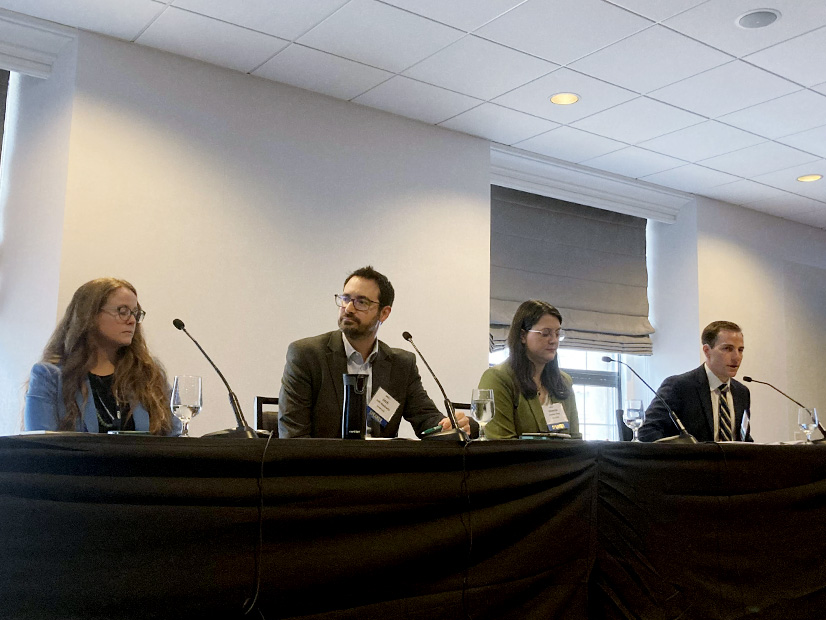
BOSTON — Transmission limits remain a major barrier to scaling up wind and solar energy to meet state decarbonization goals, speakers at the Northeast Energy and Commerce Association’s Renewable Energy Conference said March 8.
The conference featured panels on offshore wind, resource interconnection and networked geothermal heating, but grid constraints were a major theme throughout the day.
“We are in full recognition that a lot of work needs to be done on the grid in order to interconnect a lot of offshore wind projects,” said Joanna Troy, deputy commissioner of the Massachusetts Department of Energy Resources. Coordinating the planning and cost allocation for this transmission will be key components of scaling up offshore wind, she said.
Troy highlighted the work of the state’s Interagency Offshore Wind Council, which is conducting stakeholder engagement for a “strategic offshore wind road map” the administration intends to release in late summer or early fall.
Andrea Hart of Atlantic Shores Offshore Wind stressed the importance of coordinating planning efforts for offshore wind transmission.
Connecting an increasing number of offshore wind projects in an uncoordinated manner could create a “spaghetti dilemma,” with separate lines connecting to the shore at different points, Hart said. This could increase project costs, timelines, environmental impacts and local opposition.
Hart said separating offshore wind development and transmission into separate procurements can help reduce the development risks, highlighting ongoing processes in New York and New Jersey.
“States are starting to do this, but it is still in a piecemeal fashion,” Hart said. “States aren’t yet in this place where they can come up with transmission solutions that transcend state lines, that transcend ISO or RTO territory.”
Hart added that until transmission solutions are “waiting and ready to be used by developers, generators are going to bake in a lot of risk into their prices.”
Reducing the number of transmission lines landing onshore could also help reduce the opportunities for lawsuits from local opponents. The first wave of offshore wind projects under development has faced a series of so-far-unsuccessful lawsuits aimed at halting them. (See Another Federal Lawsuit Seeks to Invalidate OSW Approvals.)
Josh Kaplowitz, senior counsel at law firm Locke Lord, emphasized the importance of early and meaningful engagement with host communities.
“It’s critical to go into communities early to share facts on the benefits of offshore wind, listen to concerns and adapt projects if feasible,” Kaplowitz said. At the same time, “at this early stage in the industry, when people are still getting used to offshore wind, you’re not going to prevent all lawsuits. It’s unlikely that you’re going to be so good at community engagement that no one’s going to want to challenge projects.”
The transmission constraints in New England are not limited to gigawatt-scale offshore wind projects; they also impact smaller onshore projects connecting to both the transmission and distribution networks.
Speakers on a panel focused on interconnection expressed cautious hope about the effects of FERC Order 2023. ISO-NE is planning to file its compliance proposal at the beginning of April. (See related story, NEPOOL PC Backs ISO-NE Tariff Revisions for Order 2023 Compliance.)
“I think it’s a great step in the direction of holistic planning,” said Sheila Keane, director of analysis for the New England States Committee on Electricity. “When I think about Order 2023 and the broader context of where we’re going, we’re going to need a lot more resources coming online.”
Barry Ahern, director of transmission planning and asset management for National Grid, said he is “trying to remain on the optimistic side” regarding the impacts of the order on transmission interconnection.
The order will likely make it “more predictable when you will get your results, but more unpredictable on what they will be,” Ahern added.
Weezie Nuara, assistant secretary for federal and regional energy affairs at the Massachusetts Executive Office of Energy and Environmental Affairs, applauded ISO-NE’s incorporation of stakeholder input into the Order 2023 compliance proposal.
“It really does seem to be a good news story of the stakeholder process working for all of us,” Nuara said. “Of course, there can be further improvements, and it remains to be seen how effective all these reforms will be. These are massive changes, moving from first-come-first-served to first-ready-first-served with a cluster study approach.”
The order could also affect state-jurisdictional projects connecting to the distribution system, Nuara added.
“I’m very curious to see how the coordination with [affected system operator] studies plays out,” Nuara said, adding that some interconnection customers to the distribution system “are also having to undergo transmission studies because they’re just such large clusters of distributed generation requesting interconnection to the distribution system. So that is having knock-on effects on the transmission system, and ISO New England has gotten involved in a big way.”
Nuara expressed hope that Order 2023 compliance “will maybe help corral some of the study work that’s going on for [distributed generation] projects.”
